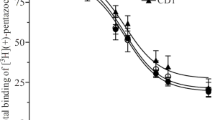Abstract
The heterogeneity of rat brain opiate receptors was examined by analyzing competition data. The binding of three prototypical tritiated opioid agonists, [3H]-dihydromorphine ([3H]-DHM), [3H]-D-ala2-D-leu5-enkephalin ([3H]-DADLE), and [3H]-ethylketocyclazocine ([3H]-EKC) was determined in the presence of varying concentrations of each of these unlabeled ligands, generating nine displacement curves. A computer program was then used to find the best fit of a model system to these data, assuming two, three or four independent binding sites. The best fit was a four-site model. One of these sites is specific for DHM; two are relatively selective for DHM and DADLE respectively, but also bind EKC. The remaining site binds only EKC with high affinity. These results, together with displacement data using naloxone, FK33824, and D-ala2-met5-enkephalinamide, are discussed in terms of current opiate receptor models.
Similar content being viewed by others
Literature
Chang, K. J. and P. Cuatrecasas. 1979. “Multiple Opiate Receptors: Enkephalin and Morphine Bind to Receptors of Different Specificities.”J. biol. Chem. 254, 2610.
Friedman, H. H., M. F. Jen, J. K. Chang, N. M. Lee and H. H. Loh. 1981. “Dynorphin: A Possible Modulatory Peptide on Morphine or β-Endorphin Analgesia in Mouse.”Europ. J. Pharmacol. 69, 357.
Garzón, J., P. Sánchez-Blázquez, J. Gerhart, H. H. Loh and N. M. Lee. 1984. “Dynorphin 1–13: Interaction with Other Opiate Ligand Bindingsin Vitro.”Brain Res. 302, 392.
Goodman, R. R., S. H. Snyder, M. J. Kuhar and W. S. Young, III. 1980. “Differentiation of Delta and Mu Opiate Receptor Localization by Light Microscopic Autoradiography.”Proc. natn. Acad. Sci. U.S.A. 77, 6239–6243.
Lee, N. M. and A. P. Smith. 1980. “A Protein-Lipid Model of the Opiate Receptor.”Life Sci. 26, 1454.
Lord, J. A. H., A. A. Waterfield, J. Hughes and H. W. Kosterlitz. 1977. “Endogenous Opioid Peptides: Multiple Agonists and Receptors.”Nature 267, 495.
Pasternak, G. W. 1982. “High and Low Affinity Opioid Binding Sites: Relationship to Mu and Delta Sites”.Life Sci. 31, 1303.
Rothman, R. B. and T. C. Westfall. 1982a. “Morphine Allosteric Coupling Between Morphine and Enkephalin Receptorsin Vitro.”Mol. Pharmacol. 21, 548.
— and —. 1982b. “Morphine Allosterically Modulates the Binding of3H_Leucine-enkephalin to a Particulate Fraction of Mouse Brain.”Mol. Pharmacol. 21, 538.
Tulunary, F. C., M. F. Jen, J. K. Chang, H. H. Loh and N. M. Lee. 1981. “Possible Regulatory Role of Dynorphin on Morphine- and Endorphin-induced Analgesia.”J. Pharmac. exp. Ther. 219, 256.
Author information
Authors and Affiliations
Rights and permissions
About this article
Cite this article
Landahl, H.D., Garzón, J. & Lee, N.M. Mathematical modeling of opiate binding to mouse brain membrane. Bltn Mathcal Biology 47, 503–512 (1985). https://doi.org/10.1007/BF02460010
Received:
Issue Date:
DOI: https://doi.org/10.1007/BF02460010




